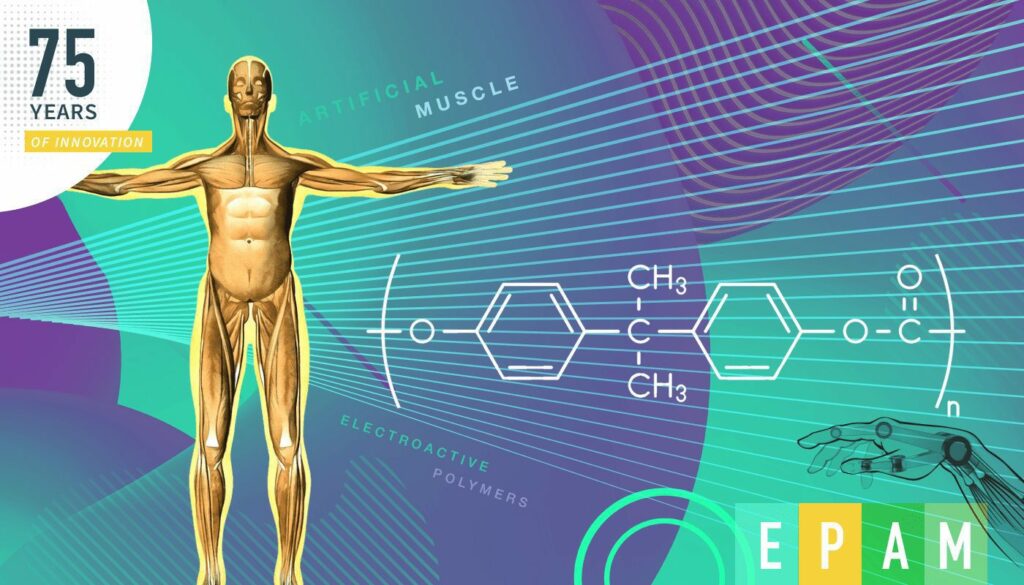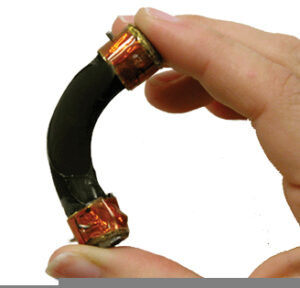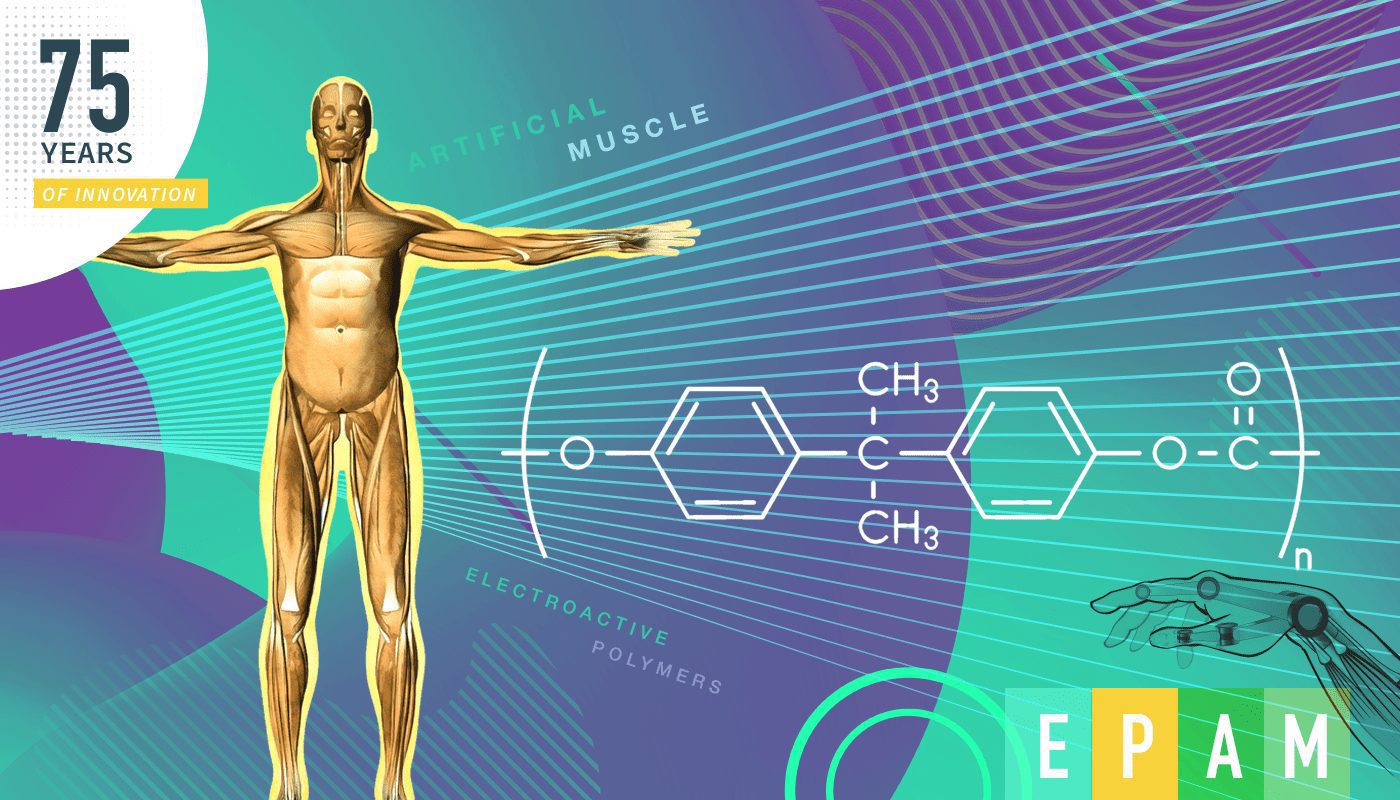The 75 Years of Innovation series highlights the groundbreaking innovations spanning from SRI’s founding in 1946 to today. Each week, SRI will release an innovation, leading up to its 75th anniversary in November 2021.

The development of Electroactive Polymer Artificial Muscle (EPAM) technology used in artificial muscle to service multiple commercial uses.
Flexing an artificial muscle: How artificial muscle electroactive polymers (EPAM) changed the game
“Artificial Muscle Inc’s EPAM-based UMA technology has the potential to revolutionize the small actuator industry because of its market-changing light weight, high power density characteristics” — Vishnu Sivadevan, Frost & Sullivan Research Analyst
Many of us take our muscles for granted. We lift up a coffee cup to take a drink and as we do so, muscles in our arms, hands, and face all work in harmony to give us that caffeine boost. But what if the power, flexibility, and fine-level control of natural muscles could be used in industrial automation, commercial, aerospace or a healthtech context?
Human beings understand the elegant power of the muscle: with a contraction and relaxation of a few muscles, homes are built, children cradled, races won. Artificial Muscle Electroactive Polymer (EPAM) was an invention by researchers at SRI International to reflect the delicately balanced capabilities of natural muscle to create an artificial version that could be used across industry.
Let’s take a closer look at how SRI developed the mighty artificial muscle using Electroactive Polymers.
The technology behind artificial muscle electroactive polymers (EPAM)
An Electroactive Polymer Artificial Muscle (EPAM) is an actuator based on an elastomeric, dielectric polymer film, typically 10 to 200 [µm] thick. Dielectric polymers are usually ‘electronic’ Electroactive Polymers (EAPs) and are a key part of an Electroactive Polymer Artificial Muscle as they offer flexibility, are cost-effective to manufacture, and chemically stable.
The actuator operates via two surface layers: the first electrode layer contacts the first surface of the polymer layer; the second electrode layer contacts the second surface of the polymer layer. There is a support structure between the actuator and a sonic actuator film. This creates the basic arrangement of an EPAM — when an electric current is applied the two attracting electrodes compress the sheet in a horizontal direction.
If we compare EPAM to how a human muscle works. Natural muscle is a biological actuator that converts chemical energy into kinetic energy which is used for mechanical work — like lifting a coffee cup. In much the same way, an EPAM will contract on exposure to an electrical current and contract if that current is removed — it will also hold a position with almost no current needed. The EPMA-based artificial muscle, like a real muscle, converts electrical energy into (programmable) mechanical motion (kinetic energy).
The unique features that the dielectric polymer film offers to an EPAM-based product is in enhanced energy efficiency. This means EPAM-based products can be made more commercially viable by being lighter, more robust, cheaper, and (as mentioned) energy saving. EPAM-based products are also quieter and non-toxic. This latter feature makes EPAM a candidate for medical devices that require the mechanical capability of a muscle.

The place of artificial muscle electroactive polymers in the history of technology
In 2003, SRI International spun-out a company, Artificial Muscle, Inc. (AMI). AMI went on to commercialize SRI’s patented EPAM technology to use in audio speakers, power generators, motors, pumps, valves, sensors, and medical devices. The Electroactive polymers used in EPAM are the key to the performance of the technology.
AMI used silicone and acrylic polymers in the commercialization of EPAM.
In 2006, AMI won the Frost and Sullivan, Actuator Technology Product Innovation of the Year Award for their Universal Muscle Actuator™ (UMA™).
In the October 2003 edition of Scientific American, the headline was “Artificial Muscles: Shape Shifting Plastics Replace Motors in Machines That Move”
In 2010, Bayer MaterialScience LLC acquired Artificial Muscle, Inc. (AMI). One of the technologies to come out of this acquisition was used to develop highly realistic haptic feedback for gaming, based on artificial muscle technology. The haptic touch product ‘ViviTouch’ was the result. The truly game-changing thing about ViviTouch, afforded by the application of EPAM, was the fine level of control and feedback achievable using the technology. Writing at the time, one publication said of ViviTouch, “The main benefit of ViviTouch’s actuators is that it can create movement so fast and fine that it can convey countless different types of feelings….ViviTouch has the ability to convey subtle things like a ball rolling against wood, or a car’s gears shifting.”
The future for artificial muscle based on EPAM technology includes applications in robotics and smart speakers. The concept of ‘super artificial muscles’ is also proposed as a near-future project for artificial muscles for use in prosthetic or orthotic devices.
With the capability offered by EPAM-based products, the 1970s series about the “6 Million Dollar Man” may well become a reality.
Interested to see more from SRI?
Visit sri.com.
Resources
Chiba, S., et.al., Electroactive Polymer Artificial Muscle, J-STAGE Vol 24, №4 May 2006: https://www.jstage.jst.go.jp/article/jrsj1983/24/4/24_4_466/_pdf
Pelrine, R., et.al., Elastomeric dielectric polymer film sonic actuator, United States Patent 6343129, 01/29/2002: http://www.freepatentsonline.com/6343129.html
Hexapod Robot using EPAM: https://www.youtube.com/watch?v=7Qxvyw5tUko
Scientific American October 2003, Vol. 289: https://www.scientificamerican.com/magazine/sa/2003/10-01/
Artificial Muscle Inc’s Universal Muscle Actuator Named Actuator Technology Product of The Year by Frost & Sullivan: https://www.prweb.com/releases/2006/06/prweb401821.htm
Artificial Muscle, Inc., (AMI) press release, Electroactive Polymer Artificial Muscle — EPAM — Development Kits Available from Artificial Muscle, Inc.; Seven Different Configurations Available for March Delivery, February 2005: https://www.businesswire.com/news/home/20050228005373/en/Electroactive-Polymer-Artificial-Muscle—EPAM—Development-Kits
Bayer MaterialScience acquires Artificial Muscle, Inc.: https://www.k-online.com/en/News/K_Archive/Bayer_MaterialScience_acquires_Artificial_Muscle,_Inc.
Engadget, ViviTouch haptic technology hands-on: electroactive polymer giving a ‘high definition feel’: https://www.engadget.com/2011/09/17/vivitouch-haptic-technology-hands-on-electroactive-polymer-givi
Destructoid magazine, ViviTouch: The future of feedback: https://www.destructoid.com/vivitouch-the-future-of-feedback-268877.phtml
JChiba, S., Dielectric elastomer artificial muscles (Energy harvesting and high- efficiency actuation), Mater Eng Appl Vol.1 №1 October-2017: https://www.pulsus.com/scholarly-articles/dielectric-elastomer-artificial-muscles-energy-harvesting-and-highefficiency-actuation.pdf
NBC, Six Million Dollar Man: https://www.nbc.com/the-six-million-dollar-man



